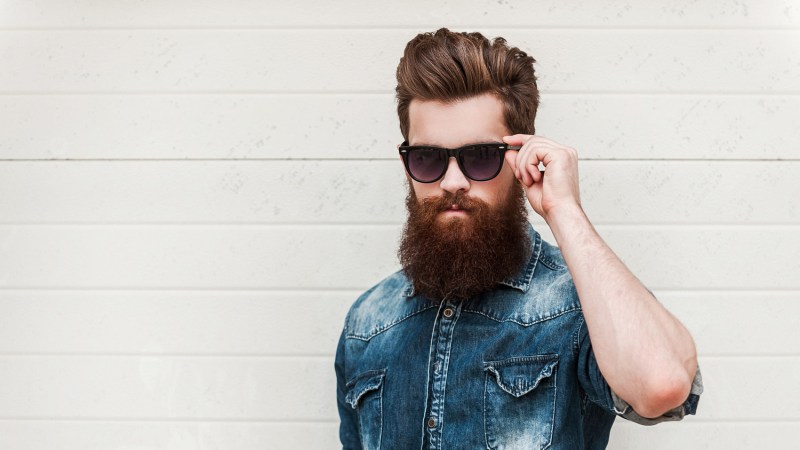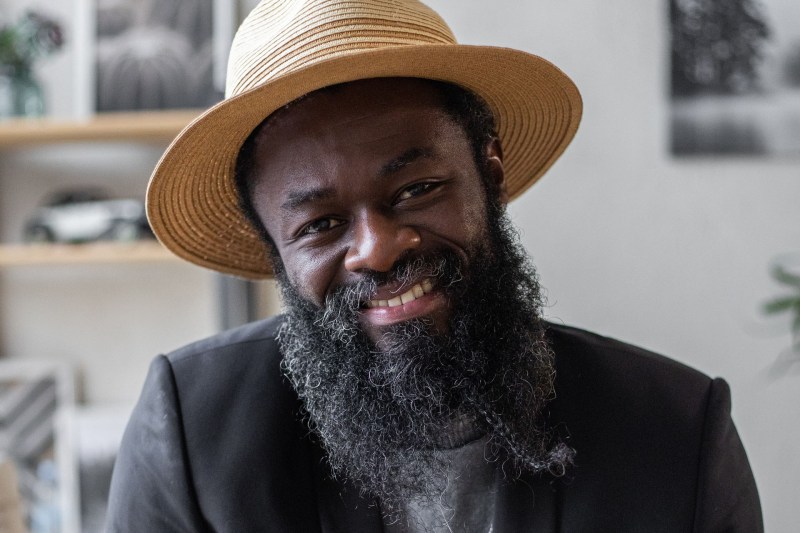Guys add beards for many different reasons. Some want to make a statement, and others want a new look. The novelty factor is key sometimes, and some of us have even been prodded into the bearded world by a significant other who expressed curiosity (while wondering what that really meant, of course).
I sported what I used to call an Amish beard for a long time — i.e., full beard, no mustache — because I thought it was a good look for me. (This is also now known as a whaling beard, I learned while doing this piece.) I have a long, narrow face, plus I’m part Scotch-Irish, so it made sense at the time.
As I got used to the commentary about the beard, though, I began to notice that there were certain distinct “types” when it comes to beards and the possibility of adding them, so I decided to use that conceit to get some advice from the pros.
The Complete Beard Kit from Live Bearded has everything you need to wash, condition, moisturize, and style your beard. With their simple three-step routine, you’ll have a beard that looks better, feels softer, and stays healthier from root to tip. Don’t miss out—grab yours now while it’s on sale!
The beard beginner

Typically, beginners should stick to basics when it comes to their first real beard. For starters, there’s no way to know what you’re going to be dealing with until your first beard grows in, and that can take weeks.
“Start with something longer than a five o’clock shadow to get used to the feel of having a beard,” says celebrity stylist and PURA D’OR partner Clyde Haygood. “[Beards] can get itchy or irritate the skin, which can cause ingrown hairs or breakouts. Take it slow, and the texture of your beard hair and the condition of your skin will let you know if you’re a good candidate to go further.”
If you do give your beard a green light, it’s important to start adding tools. Get used to using a trimmer, and start shopping for scissors if you’re going to to all the way and grow it out.
Products matter, too. Nearly every hair and beard stylist I interviewed recommended getting beard oil to soften your new beard and nourish your skin, and several recommended beard oils. Clyde Haygood specifically recommended PURA D’OR beard oil, but rest assured; there are plenty of other good choices on the market. Getting familiar with these products might feel a little premature, but it’s never too soon to start laying the foundation for that perfect beard.
As you do, consider the entry-level choices: A box beard, maybe, or a basic goatee to learn the ropes. These simple styles will also keep you under the radar if you work in a corporate environment or run in conservative beard circles.
“Using a trimmer will keep you looking ‘maintained’ instead of unkempt during the grow-out process,” adds David Connor, the owner and curator of the Anti-Gravity Salon in New Orleans. “Use the timer to outline the perimeter of the beard, such as the cheekbone, neck area, and mustache.”
If you’re growing out your bead for more than ten days, Connor is one of those stylists who recommends beard oil to soften the hairs, and it will also seep down and nourish the skin. Beard balms are an extension of that for those who decide to go for what Connor calls a more “robust” beard.
The beard pro

Now, let’s talk about the beard pro. He’s got plenty of options, and he knows it. He’s studied the styles, and he’s aware of the requirements when it comes to grooming demands and the time they’ll require. The beard pro also knows that products will be involved, and that care and maintenance is essential.
But the beard pro isn’t necessarily intent on growing out a woolly mammoth beard. He also knows when less is more. That means there’s a possibility that even a beard pro might go basic, but if that happens, he’ll be armed with the knowledge and experience to do it right.
“Goatees and more specific beard styles come into play once you know what you’re looking for,” says Ryan Gonzalez, the founder of Church Barber and Church California. “The circle beard and the goatee are about as classic as it gets, so you can’t go wrong with either of those.”
But beard pros can also go with big beards, which means they may have to make some changes. According to Brandon Faulk of Church Barber, stylistic trends tend to be circular, and that includes big
“Big beards are coming back,” he says. “So if you’re going with this choice, give it a lot of length. You may have to add to your tool kit with things like styling paste and a wide tooth comb. You may even want to consider a hair dryer.”
That’s especially true if you’re shifting styles. “If you’re doing a big beard as a change up from your current style, the general rule is the more hair the better,” agrees Robin Staz, a barber at the BeardBrand Barbershop in Austin, Texas.
Big beards sometimes need course corrections

Sometimes, though, even the pros don’t get it exactly right the first time around. Big beards are especially prone to errors in judgment, but there are fixes available.
“One common mistake I see with longer beards is neglecting the hair underneath, especially on the neck,” says Tatum Neill, the Lead Designer of Aveda Arts and Sciences Institutes. “Since the front of the beard covers it, it’s easy to overlook, but from the side, an unkempt neckline can throw off the overall look.”
Thankfully, the solution to this neglect is simple. “Grab a three-way mirror and check your beard and haircut from all angles,” Neill says. “Keeping the neck hair trimmed and shaped will give your profile a sharper, more polished appearance.”
That sharper difference can make all the difference in the world as well. “Keep it clean, keep it shaped, and your beard will thank you,” Neill concludes.
The perfectionist

Now, it’s time to get meticulous. In theory, the perfectionist is open to anything, beard-wise, which means it’s time for a short lesson in some exotic possibilities he might like.
One is the Balbo. The beard is disconnected from the mustache in this beard style, which helps emphasize that perfect jaw line if you happen to have one.
The Van Dyke is another. The sharp goatee that defines it is instantly recognizable, and so is the detached mustache. For perfectionists with an interest in art and history, the Van Dyke beard was big back in the 17th century. It gets its name from Anthony van Dyck, a Flemish baroque painter who made a career out of painting European nobility, with King Charles I as his most famous subject.
Another option for culture-loving beard perfectionists is the Verdi beard. It’s named after the famous Italian composer whose works are well known in the opera world and beyond, and Verdi also sported a beard that was round and well-groomed, with a stylish mustache as icing on the cake. The overall look was polished but still bold, so it’s a great way to shift beard gears.
As long as we’re hitting the “famous Italian beard men” category in our little facial-hair game of Jeopardy!, the Garibaldi is named after the Italian revolutionary and general, whose first name happens to be the same name as Verdi.
Regardless of how exotic or Quixotic the perfectionist’s beard choice might be, great stylists usually have plenty of experience with this beard type, which means they know his tendencies.
“[Their] actual beard choice is about personal style, as is the amount of drama they want to achieve,” Clyde Haygood summarizes. “But he will want to keep his beard boxy with clean lines. The perfectionist is going to want to have all the tools for trimming to keep his edges sharp, clean, and tidy.”
Perfectionism means having the best tools to do the job right, and no aficionado seeking the perfect beard should ever be caught without them.
“For beard professionals, I recommend a sulfate and paraben-free beard wash,” says Nick Karel, the Lead Barber at The Barbershop Cuts & Cocktails at The Cosmopolitan of Las Vegas.“That means beard oil for shorter lengths and beard balms for longer beard lengths. And beard boar bristle brushes and combs are excellent for controlling unruly beards.”
The iconoclast

Finally, let’s consider the iconoclast. He’s definitely different, and he wants his beard to be, too. He might be a woodsman or maybe a hipster. Whatever his cultural orientation, though, the iconoclast wants his beard to be as different as he thinks he is.
This guy has choices, and they cover a lot of ground. If he wants to go big, he can go with a Viking beard or use a variation on the Viking theme. Big beards are definitely a thing these days, and Robin Staz adds an intriguing variation to make it utterly unique.
For those pros who want a total Viking look, there’s the forked beard. It splits in two at the bottom — maybe even three or four for some wearers — so if you’re one of those conqueror types who likes to take what’s his in life, this beard will help you make that statement.
“I love the idea of having a beard in braids,” Staz says. “It can help you separate from the herd.”
Separating from the herd comes with big risks, but Staz is willing to take them on. You can even follow the lead of a certain musical legend if you want.
“You don’t even have to do multiple braids, actually,” he says. “You can just to with one big one, kind of Willie Nelson-ish.”
For those who prefer a more minimalist style, there are still ways to look unique. One is the “beardstache,” which multiple stylists loved, and the iconoclast can use the mustache part of that combination to be unique.
“We have seen quite an emergence of mustache styles, and I’m not seeing it,” says Nick Karel. “It’s definitely not going away any time soon!”
Neither are beard styles. They’re definitely proliferating, with new stylistic variations coming online all the time. That means that whatever beard you’re into and whatever your level of experience, you can find your ultimate beard style.



